
|
SolarQuest® Institute for Renewable EnergyCommentary on graphs and charts regardingour solar powered telecenter at SQuIRE in Santa Cruz, California. |
| 2003 April 22: Battery Change. On April 18th the battery bank was changed. (Note battery voltage going to zero for a period of time during the changeover.) The difference is obvious and profound. The new batteries hold a charge. More equipment is being added to the load now that the batteries can hold the energy generated by the solar system. | 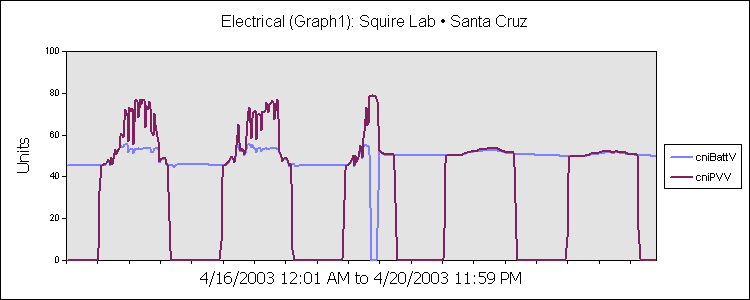
|
||
| 2002 October 2: PV Volts are high. Why? Because the batteries are fully charged and the PV panels assume their open circuit voltage. |
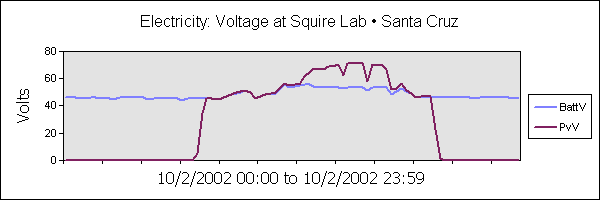
|
||
| 2002 August 9: Solar System off, inverter to LBX mode. Yesterday we turned off the solar system and set the inverter to LBX mode, Low Battery Transfer. Consequently, the battery was discharged until the batteries reached the low voltage set point of 44 volts, after 16 hours of autonomy. Then it recharged, whereupon we switched the solar system back on again. The inverter continues in LBX mode, so the batteries will cycle, rather than maintain a steady voltage. |

Click on graph to see curves on larger scale, correlated with battery voltage. |
||
| 2002 June 26 - July 17: Energy data was not being taken while modifications were in progress. (Negative amounts were generally due to sensor defaults.) Environmental data was not recorded from about June 26 through July 7. See also oscilliscope-type patterns for certain devices. | |||
|
2002 June 10: Solar Eclipse. On June 10 the partial eclipse of the sun was about 70%. It was a perfect sunny day, so there are no other obstructions -- you can clearly see the impact of the eclipse on our solar radiation data. (Click on the graph to see a more detailed view.)
|

|
||
|
|
|||
| 2002 April 25: Averaging. Originally we were taking samples every 15 minutes. Now we have changed the formula: we sample every minute, take the average, and report the average every 15 minutes. This graph, with 15 minute sampling on the left, and averaging on the right, dramatically demonstrates the difference that averaging makes. The 24 volt circuit is measuring the refrigerator motor, which spikes regularly several times a day. By averaging, we now know total consumption over a period, but in the tradeoff, we have lost information about the current peak. | 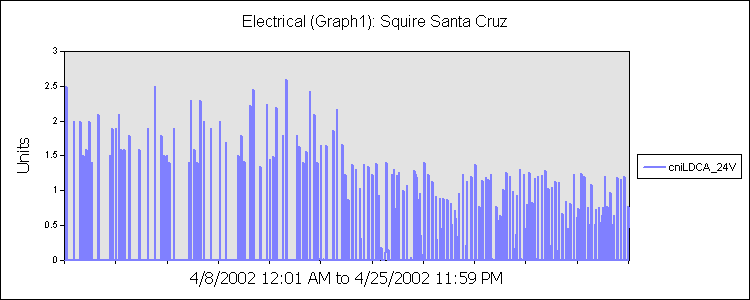
|
||
|
|
|||
|
2002 April 16: Gap in Data. Shortly after 1:00 AM there was a power outage. Our SQuIRE server and Weather Station went down. (EcoWeb, our solar powered webserver, kept operating.) You will see a gap in data, and zero values for a short period. (Actually the disabled temperature sensor shows -20° C. Fortunately, it wasn't that cold!)
We have put three C-sized batteries (with about 12 watt-hrs capacity each) in the Davis Vantage Pro to avoid data loss through a power outage. We ran a test to see how long the Vantage Pro will run on 30+ watt-hours of batteries since Tuesday 4/16/2002 10:46 AM. Power was lost on Monday 6/3/2002 12:30:00 PM, after a month and a half on one set of batteries. We put it back on line at 6/4/2002 9:10:00 AM. Now we know how long the battery backup lasts. |
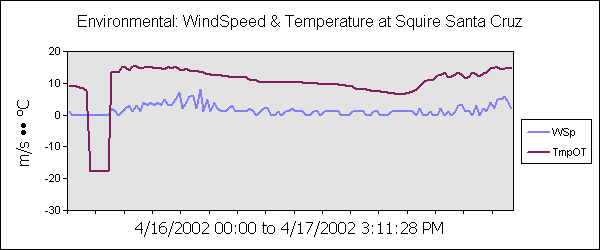
|
||
|
|
|||
|
2002 April 9: Interpreting load curves. What do the shapes in this graph represent?
These are the 12 and 24 volt DC circuits in the SQuIRE lab.
|
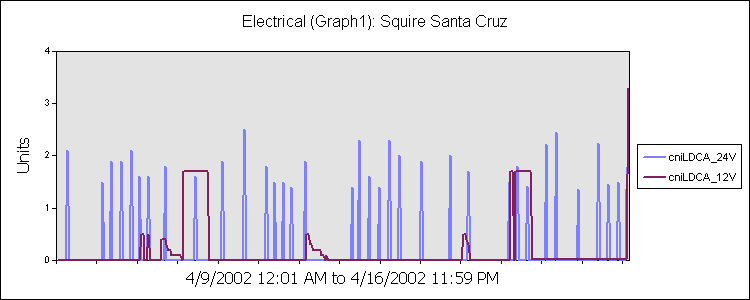
|
||
|
|
|||
2002 April 3: Not to Scale. As of this date, the data is plotted as a histogram, not as an X-Y plot. On this date, the sampling rate was increased to obtain more detail.
|
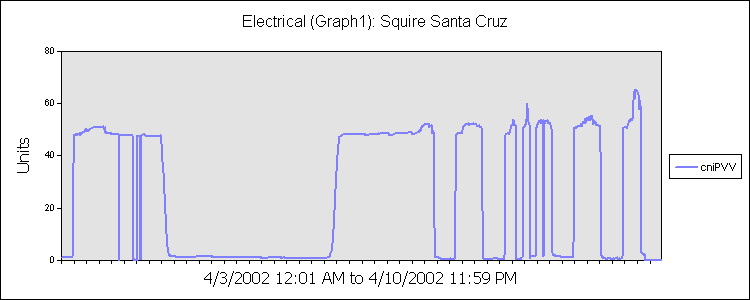
|
||
|
|
|||
